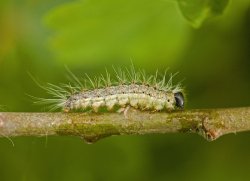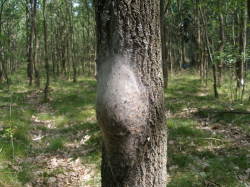Oak processionary moths
The oak processionary moth (Thaumetopoea processionea) is a pest that was introduced into the UK upon imported oak trees. It was first identified at a private development in the borough in 2006 and is now established across many parts of London.
Health risk
The caterpillars of this pest feed almost exclusively on oak trees and pose a risk to human and animal health. They emerge from minute egg plaques in April of each year, following hatching the larvae feed upon oak leaves, and go through several stages of growth which are known as instars.
As the caterpillar reaches its third growth stage it begins to develop urticating hairs. These hairs contain an irritating substance which can cause skin rashes, eye problems, sore throats and breathing difficulties for people who come into contact with them. Animals are also at threat and can suffer blistering, tongue irritation and eye problems.

Removal
We take a responsible approach towards the management of this pest. Each year, a specialist contractor is deployed to treat oak trees within our parks and open spaces in order to target the young oak processionary moth caterpillars, and prevent them from developing into a hazardous state. We also undertake surveys to identify OPM activity and carry out physical nest removal where necessary.

What to do if you see OPM
Do not approach, do not touch
It is important to be aware of this pest. Children are particularly vulnerable as the caterpillars can be seen moving around in nose to tail processions which attracts attention. Children should therefore be taught not to approach or touch them.
Pets should be restrained from approaching the caterpillars or fallen nests.
Report it
If you see any oak processionary nests or caterpillars (OPM) you should report them immediately.
If they are on a privately owned oak tree, report them to the Forestry Commission using the Tree Alert online pest reporting form. If you cannot use Tree Alert, you may report them by telephone on 0300 067 4442 or by email at opm@forestrycommission.gov.uk.
Owners of trees on private land affected by OPM are responsible for arranging removal. Details of specialist contractors who are able to manage OPM can be found via the Arboricultural Association website.
If OPM are on a council owned tree, report it to us.
What to do if people or animals come into contact with OPM
It is important not to come into contact with the caterpillars, hairs or nests. The Forestry Commission has produced a leaflet with further information on how to protect yourself and what to do if you or others are affected![]() (pdf, 682 KB).
(pdf, 682 KB).
If you think you may have been exposed and have an itching skin rash, conjunctivitis or other symptoms, see a pharmacist to relieve the symptoms. If you have a more serious allergic reaction, contact your GP or call NHS Direct on 111. The call is free from any phone. Similarly, consult a vet if your pet has a serious reaction.
Advice for contractors
Regulations are in place which affects how contractors working with oak trees should be handling material within the oak processionary moth affected areas. The Forestry Commission have produced a guidance document with further details.
More
Find out more about the oak processionary moth on the Forestry Commission website.
Up to: Tree management and pruning
Updated: 15 December 2022
 Stay up to date! Make sure you subscribe to our email updates.
Stay up to date! Make sure you subscribe to our email updates.
